Detection
Damaging Low-level Winds is the only signature that directly observes one of the four convective hazards through radar eyes. The definition of severe damaging surface winds in Australia is gusts exceeding 48 knots at 10 m AGL. Winds that close to ground level are difficult to meaningfully estimate by radar unless the storm is very close to the radar.
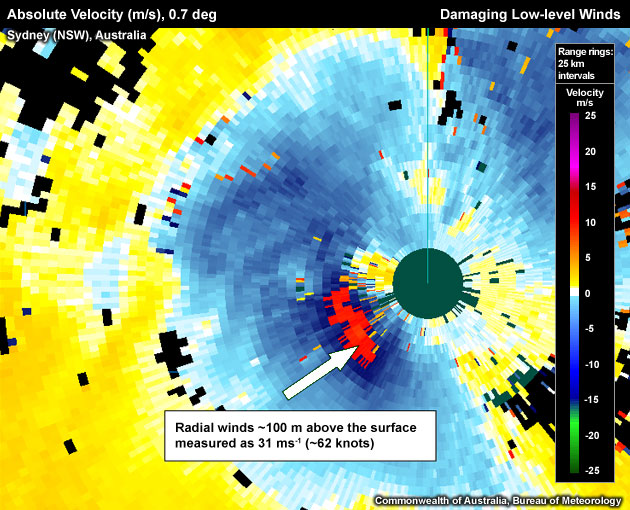
Measurement of radial winds past the severity threshold of 48 knots with the radar beam centre at approximately 100 metres above radar level.
Velocity: PPI/Plan View
- Using one of the lowest velocity tilts through a thunderstorm (particularly, pay attention to those storms that are tall, large or have intense cores), move your cursor over the individual pixels, then note the maximum radial velocity recorded. Note: Be wary of aliased data. Aliased data is common with this signature due to the strength of the wind required.
- Are there any (dealiased) velocity pixels exceeding 48 knots? To do this read the velocity off the scale bar, the info bar or the cursor data window.
- Is the damaging wind measurement obtained in (2) located close to the surface (within, say, a few hundred metres)? To determine this, read the height of the pixel off the scale bar, info bar or the cursor data window. If yes, low-level damaging winds are observed.
It is unlikely that the radial velocity observed in the Doppler channel equals the total surface wind. Three main adjustments are required to deduce the likelihood of damaging winds at the surface:
- Viewing angle: The Doppler velocity shows only the radial component of the total wind. Due to this, the Doppler velocity is most likely an underestimation of the true wind velocity, and adjustments for the viewing angle need to be made.
- Observation height: The radial velocity observed along the radar beam is most likely an overestimation of the true radial wind at the surface given that the total wind generally increases with height due to the decreasing influence of surface friction with height. The stability of the atmosphere would have the greatest impact on the shape of the velocity wind profile. The lower the stability of the atmosphere, the more vigorous the eddies, and therefore the stronger the transfer of vertical momentum. There are, of course, exceptions to the rule that wind speeds should increase with height. In microbursts the strongest horizontal winds can be very close to the ground.
- Radar sampling: The observed radial velocity on the radar display is an average of individual measurements throughout a broader pulse volume. Wind gusts can occur on a scale smaller than the pulse volume and would therefore be averaged with individual wind measurements that are less strong. This averaging process overall means that the radar measurement is an underestimate of the strongest winds within a pulse volume.
In summary, radar yields pulse-averaged radial velocities (a double underestimate of the total velocity) above the surface (mostly an overestimate of the total surface velocity). Ideally, forecasters should endeavour to apply a viewing angle, pulse averaging and a height correction to estimate the total surface winds from the observed radar velocities at the lowest scanning angles.
There are a number of signatures that could be used as precursor to the onset and detection of damaging winds. Any of the signatures suggesting the presence of a strong updraft, could be used as an alert to the potential of a strong downdraft and damaging winds. For microbursts, the presence of strong low-level divergence signature could be a very short lead time precursor to the onset of damaging winds. Also for microbursts, midlevel convergence near a descending precipitation core (a.k.a. a Mid-Altitude Radial Convergence or MARC signature) might herald a microburst formation (not shown).
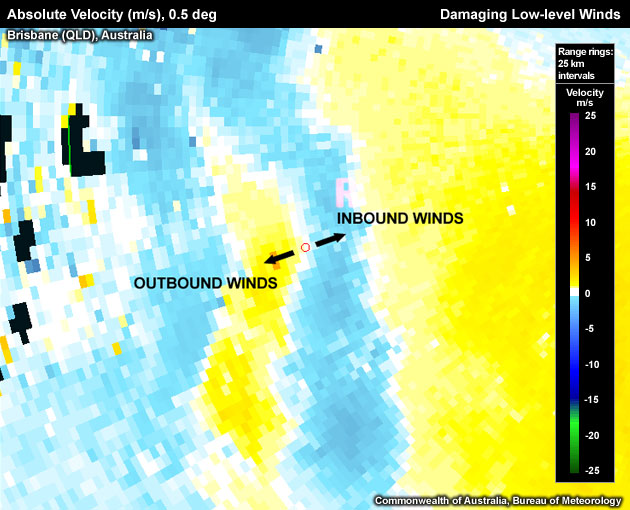
Low-level divergence signature, a potential precursor for damaging winds at the surface for the special case of microbursts.
Potential Difficulties in Detection
- Aliasing – Forecasters may either not detect the signature, or are unable to determine the actual radial velocity due to velocity aliasing.
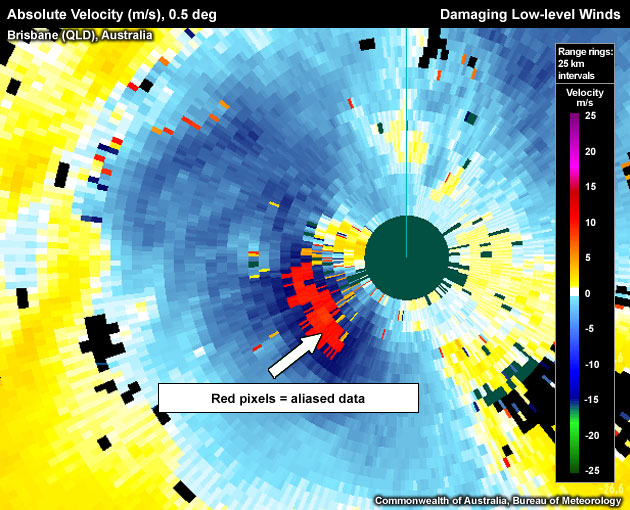
Measurement of radial winds past the severity threshold of 48 knots with the radar beam centre at approximately 100 metres above radar level. Strongest winds are aliased in red. "Hot" pixels are evident to the northwest of the radar.
- "Hot" velocity data – As damaging winds are often shown as a small area of pixels, poor velocity data could easily be mistaken as true extreme values. To establish pixel value credibility, check that the suspected high velocity pixels exhibit some continuity in space and time.
- Ground clutter breakthrough: It is desirable to obtain radar-based wind estimates as low to the ground as possible, which automatically increases the likelihood of ground clutter breaking into the velocity image.
- The thunderstorm is located too far from radar – Therefore the radar overshoots a shallow layer of damaging near-surface winds.
Examples of Damaging Low-level Winds

Measurement of radial winds around 60 knots near Sydney airport on 2 February 2005 as a supercell tracked across the area. The maximum radial velocity pixels are located around 100 m above radar level.
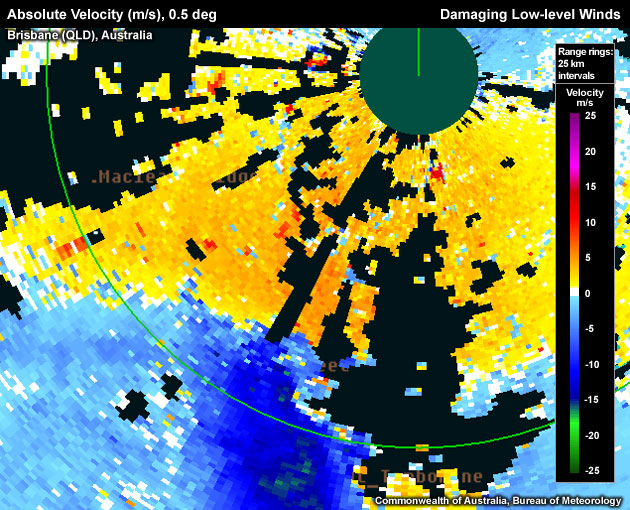
Destructive radial winds of 34.4 m/s (~69 knots) in the rear-flank downdraft region of a northeastward tracking supercell south of Brisbane. These radial winds were observed around 400 m above radar level.
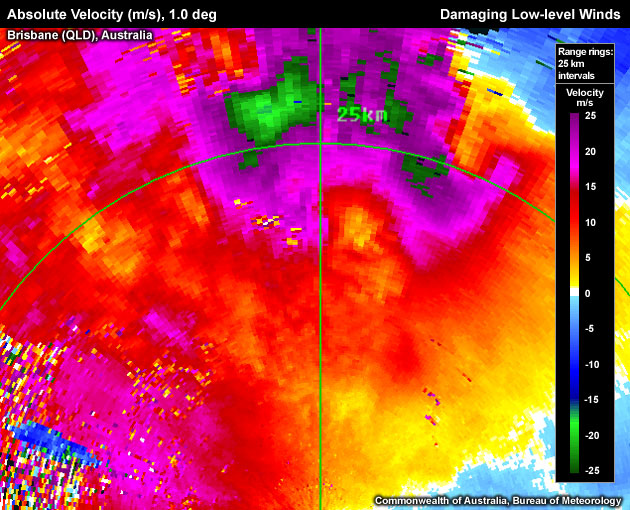
Destructive radial winds of 35.8 m/s (~72 kts) at ~700m ARL associated with "The Gap" storm west of Brisbane. Note the ground clutter breakthrough west of the radar location.
Damaging Low-level Winds Look–a–Likes
"Hot" pixels – Either due to dual PRF technique (increases Nyquist velocity without decreasing maximum unambiguous range), or ground clutter affecting the velocity pixels.
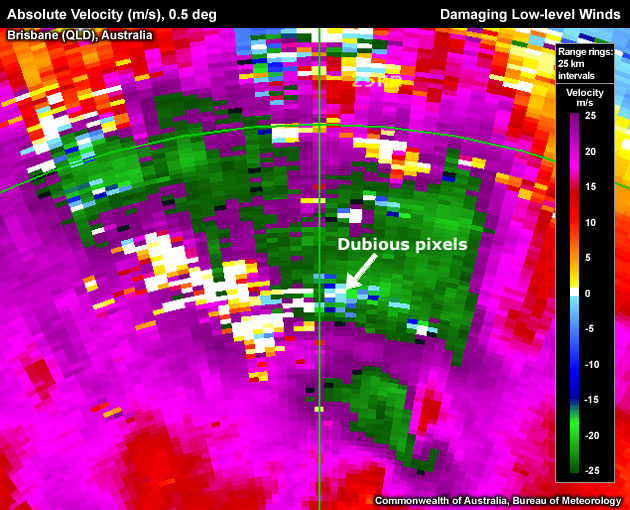
Low velocity tilt of the Gap storm west of Brisbane seemingly showing aliased outbound velocities that folded back onto the zero line (suggesting that the measured speed is twice the Nyquist velocity of 27.2 m/s, or 54.4 m/s ~ 109 knots). Note that along the radial containing the "dubious" pixel, unphysical pixel to pixel velocity jumps of 24 m/s occur. Apart from the inflated magnitude of the signature, however, the overall signature still shows damaging low-level winds.
Use the radio buttons or click the image to switch between reflectivity and velocity imagery:
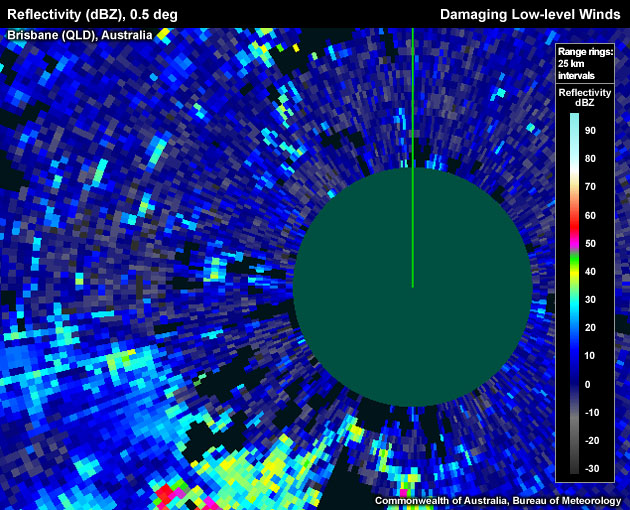

The velocity image seemingly shows three patches of very strong outbound velocities south, west and northwest of the radar. A comparison with the associated reflectivity distribution shows that no convective echoes are linked to any of the above three velocity peaks, which are probably due to ground clutter breakthrough.
